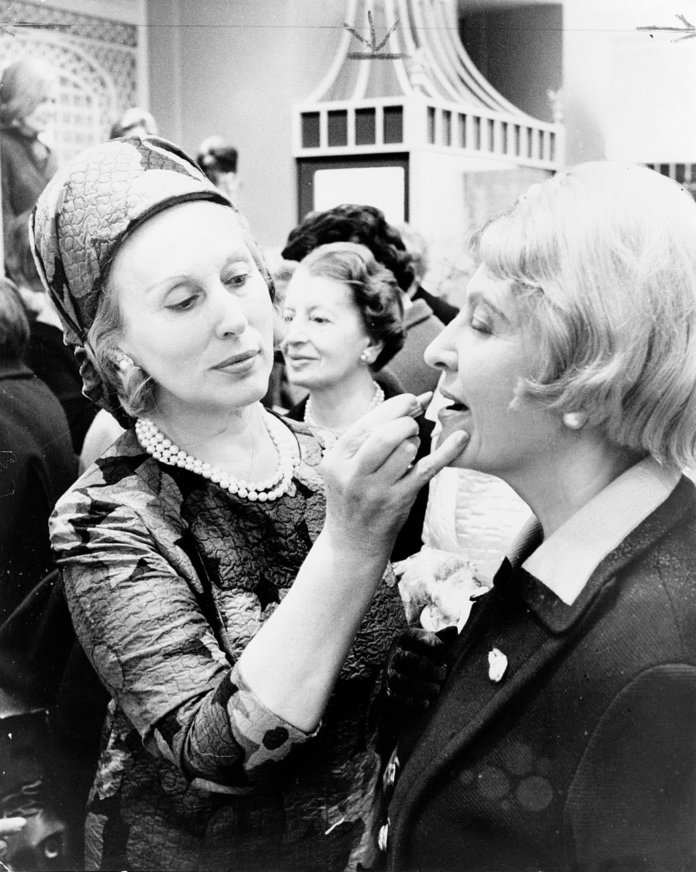
If there was one thing Estée Lauder – whose name still rules the beauty industry even after her passing in 2004 – knew well, it was the power of an attractive image. Since the Lauder fortune began with Estée and her uncle, John Schotz, selling creams and “secret” beauty products to New Yorkers, this may seem less than revelatory. But Estée’s understanding of image went far beyond recognising the desire for a youthful appearance. Every decision, from the changing of the spelling and pronunciation of her name to appear more French, to her strategic social climbing and the use of celebrity faces (which today includes known style icons like Victoria Beckham) was intended to present a brand that would be viewed as nothing less than the premier choice for beauty. Thus, Estée would go from being born Josephine Esther Mentzer and living above a hardware store in the Corona section of Queen’s, New York, to the only woman on Time magazine’s 1998 list of the 20 most influential business geniuses of the century.
An Entrepreneurial Beauty
According to family, Estée was always concerned with appearance, perhaps in large part due to her desire to become an actress. As a child, Estée wished for her “name in lights, flowers” and “handsome men.” Unfortunately, working in her father’s hardware store gave Estée little opportunity to explore acting. It did, however, provide her with a foundational understanding of entrepreneurship and successful retail. Estée watched her father’s generosity with his customers, sending Christmas gifts of nails and hammers, which would later translate into her popularising the technique of free samples and “gift with purchase.” Lauder learned that it was easier to skip the battle of coercing a first-time-buy – once a product was proven effective, the customers would return.
Her obsession with appearance never faded, though, and her desire to create perfection was honed by her uncle’s move to New York after World War I, where he joined his sister (Estée’s mother) Rose’s family and commandeered the gas stove. Estée became his apprentice, helping create a line of facial creams, which soon morphed into a company called New Way Laboratories. Estée was enthralled by the chemistry which ruled her uncle’s “lab.” Years later, she would recall that she “recognised in my Uncle John my true path.” Almost immediately she began modifying John’s mixtures.
Beyond having a knack for mixing, Estée showed a tenacity for jumping social lines and fraternising with elites. Years later, myths would spread that Estée was born in Europe to an aristocratic family, as opposed to two hardworking Hungarian immigrants, an assumption she rarely corrected. Even after the true story of her youth was popularised, Lauder would recall her parents in sophisticated terms, describing her mother as, “a Hungarian beauty whose mother was a French Catholic and whose father was a Hungarian Jew.” Her father, she said, was “an elegant, dapper monarchist in Europe, who, when transported to a new country, still carried a cane and gloves on Sundays.” Her tastefulness pervaded her every interaction. For example, while still working with her uncle John, she stepped into the House of Ash Blondes to have her hair styled. After being questioned by the owner, Florence Morris, regarding Estée’s admirable skin, Estée returned to demonstrate her favourite creams and their usage. Her impromptu presentation impressed Morris so much that she asked Lauder to sell the products at her new salon. After developing her own beauty line, Estée would continue to entice potential customers by providing free demonstrations and makeovers throughout Manhattan.
In her early 20s, Estée met and married Joseph Lauter (the surname was later changed to Lauder). Their first child, Leonard, was born in March 19, 1933. Though Joseph was supportive of Estée’s continued experimentation in the beauty world, the two separated in 1939, after which Estée moved to Florida. The time apart was brief, though, and Estée remarried Joseph in 1942, returning to New York City, and reaffirming to her friends that Mr Lauder was a decent man and, in her own words: “I don’t know why I broke up with him.”
Estée Lauder Inc.
In 1944, the Lauders focused on concessions through beauty salons in New York. Mrs Lauder would appeal to fine merchandise stores to feature her products using her instinctive social skills. Soon enough, her creations were being sold in stores like Saks Fifth Avenue, which helped Estée present her products as worthy of the wealthiest consumers. The Lauders then purchased a converted restaurant for Estée to create new concoctions, and in 1947 the pair formed Estée Lauder Inc., convincing Saks Fifth Avenue to place a bulk order to finance their growth (the equivalent of $10,000 today). The couple split the workload evenly: Estée led all creative management and product development, while Joseph organised finances. There was no debate, though, that Mrs Lauder was chief executive and responsible for the company’s most integral product development decisions.
Estée was fundamental in the creation of the bath oil Youth-Dew, consisting of an egg in every jar, in 1953. Estoderme Youth-Dew was poured into the tub by the bottle, resulting in the product flying off the racks. In its first year, the perfumed oil sold 50,000 bottles and by 1984, that number had increased to 150 million annually. By 1958, Leonard had officially joined the company – today he is still the senior member of its Board of Directors. In 1960 they went international, primarily due to Leonard’s encouragement, and sold products in the London department store Harrods. In 1964 the family started Aramis Inc. to produce fragrances and other products for men. In 1959, Leonard married a young teacher, Evelyn Hausner, who was quickly brought into the family business. The Estée Lauder official website reiterates that Estée considered Evelyn, “an extraordinary asset in unaccountable ways.”
Evelyn was the first of many family members to continue the Estée Lauder legacy. She made her mark by becoming the Senior Corporate Vice President and Head of Fragrance Development Worldwide. For over 50 years, Evelyn was key in producing the Company’s most successful fragrances. Ronald Lauder, Estée and Joseph’s younger son, formally joined the company in 1964 and became General Manager of Clinique Laboratories in 1985. Evelyn and Leonard’s son, William Lauder, joined the company in 1986, eventually taking his place as Executive Chairman and Chairman of the Board of Directors in 2009. Like his father, he focused strongly on international presence and expanding the brand’s widespread portfolio. William was also key in continuing the store-within-a-store concept his grandmother had presented in her original spas. (By 1965, Estée had opened her first spa in Bloomingdale’s New York, deciding that a variety of counters would give the impression of multiple, complete spas as a way of organising the products she sold). Aerin Lauder, daughter of Ronald and grandchild of Estée, began her work with the family business in 1992 and went on to create the luxury lifestyle brand AERIN, while maintaining her role as Style and Image Director for the flagship brand of The Estée Lauder Companies. Today, the company consists of the most recognisable and coveted makeup brands available, including Aveda, Clinique, Bobbi Brown, Bumble and bumble, Donna Karan Cosmetics, and more.
The First Family of Beauty
Because of her ability to befriend recognisable style influencers, including the Duchess of Windsor, Princess Grace of Monaco and Nancy Reagan, Estée’s family had risen to new social heights, and became considered the First Family of Beauty. Despite their acceptance into the most exclusive social circles, Estée still made sure to routinely stop by locations around the world. She was famous for working directly with customers, answering questions and offering advice on colours, products, and style choices. “Telephone, telegraph, tell a woman,” was her motto – just one more business concept which reveals her futuristic understanding of social marketing.
This is a tactic that Jane Lauder, Estée’s granddaughter and current global brand president of Clinique, has not forgotten. In a recent article for Fortune, she notes, “With the rise of Instagram and Facebook and video, a lot of the niche brands have done a fabulous job of finding out how to target consumers with the right influencers – people who have huge social media followings.” Jane also insists that a still relevant Estée-strategy is to be the expert. She understands that women giving advice today are not royalty, but experimenters much like Estée herself. “When [Clinique started], it was started by a beauty editor, Carol Phillips, with a dermatologist, Dr Norman Orentreich… Fast-forward to today and who’s giving advice? It’s these women who’ve started their own beauty channels.”
It’s this understanding of word-of-mouth marketing and connection that drove Estée’s business and continues its relevancy today. As Estée said, “In many ways, women share a common language. No matter what our culture, no matter what our background, we understand each other.” Having cemented presence in both male and female fashion industries using this tactic, the Estée Lauder Companies will undoubtedly remain a cross-cultural beauty empire for decades to come.









